|
THE DRIVING GAMES BIBLE
The
history of driving games is an unusual one. Whereas most genres follow a
linear evolutionary path, becoming steadily more complex and more
technically impressive with time, driving games are different. Driving
games started in 3D and then went backwards to 2D for several years.
They started off quite technically realistic and demanding, then went
backwards and became more simplistic and easier. Graphics got prettier,
more colourful and more dramatic, then went backwards and became greyer
and duller, and so on. We needed someone intimately familiar with the
idea of going forwards then backwards to chart it all, so obviously we
called Stuart Campbell.
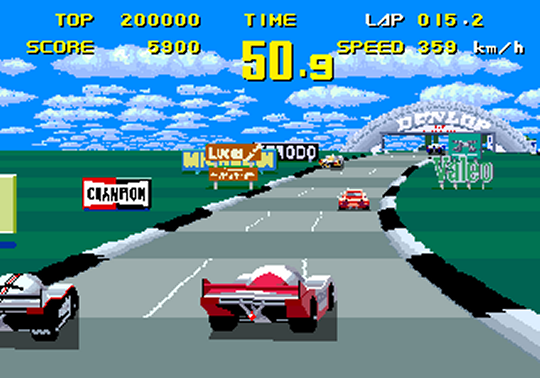
Konami’s 1986 coin-op WEC Le Mans, which isn’t mentioned anywhere in
this feature.
The first instance of driving a car in a
videogame was on Atari's 1976 classic Night Driver. A black screen
faced the player, decorated only with a series of short white posts
disappearing into the horizon to produce an eerily convincing
sensation of 3D. Speeding through the moonlit world at the kind of
game velocity the hardware could impart by, essentially, having no
graphics (even your car’s bonnet was just a plastic sticker attached
to the monitor), you couldn't afford to take your eyes off the
screen for a second.
Steering wheels were next seen in
videogame parlours on the Sprint series of overhead-viewed circuit
games, starting with Sprint 2 in 1976, confusingly followed by
Sprint 4 and Sprint 8 in 1977 and finally Sprint 1 in 1978. The
numbering doesn’t denote sequels - although the various games did
have different tracks - but the number of players. Sprint 8,
impressively, was therefore for eight players simultaneously, all
squished around one fairly normal-sized machine and making arcade
owners swoon with happiness.
To compensate for the lack of human
opposition, Sprint 1 does a remarkable and unique thing: the tracks
change while you’re driving. One minute you’re zooming round
a nice simple loop, then without warning the entire course switches
to a complex crossover route, and then a few seconds later morphs
again to a zig-zag collection of long straights, and so on. If
you’re not expecting it – and why would you be? – it’s hugely
startling and scary.
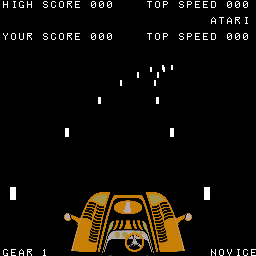
Night Driver - in fact, not even nearly the first driving
videogame. Fooled you! Ha ha!
Night Driver and Sprint both had purely
demarcative graphics – that is, wholly abstract lines and dots which
served only to mark the distinction between the traversable course
and the “walls” marking the limits of where you could go. The first
coin-op driving game to feature actual graphics in the sense we
understand the term today (that is, depicting some sort of actual
scenery) was Atari’s 1977 release Super Bug, which gave the player
an identifiable vehicle (a VW Beetle) some dense woodland to drive
through. Super Bug also saw the first introduction of “realistic”
handling – in addition to having to cope with manual switching
through four gears (something not seen in arcade games in the
following 30 years), your Bug is prone to drift, fishtailing like
crazy if you go round corners too fast. It’s an incredibly demanding
game which will leave the most dedicated modern racing fan weeping
in a corner within minutes.
Not satisfied with that, though, Atari
followed Super Bug up with the conceptually similar Fire Truck the
next year (which despite still being in greyscale also saw a
significant aesthetic improvement, with the graphics now depicting
an identifiable and rather attractive, albeit somewhat Lego-ey,
suburban landscape with houses, lawns, trees and parked cars).
Fire Truck was the first - so far the
only - co-op driving game, and saw two players charged with steering
a single fire engine through the scrolling overhead course, with one
of them driving the cab and the other trying to keep the trailer
under control. (There was a later single-player version called Smoky
Joe.) It’s absurdly difficult, and almost certainly the most
technical driving game ever created, making a mockery of Gran
Turismo fans and their fiddling with wheel balancing, brake
adjusting and grocket fondling. Only when you can complete a
90-second Fire Truck run without a crash can you consider yourself a
truly skilled pretend driver.
(Atari had also put out another highly
technical and very different coin-op driving game in 1977, the
bizarre side-on precision-gear-shift-timer Drag Race, but that
turned out to be something of a genre dead-end.)
|
TOP FIVE
The
building blocks of the modern racer
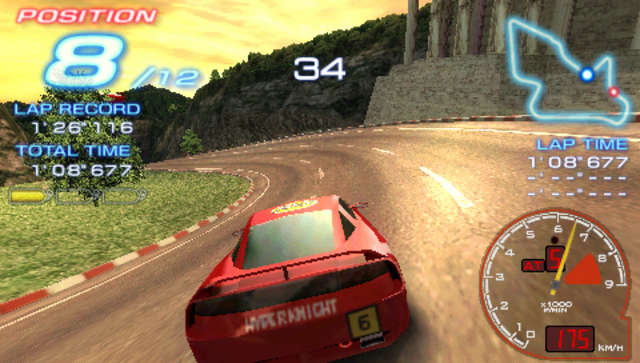
New-fangled high-definition Ridge Racer is very pretty
and all that, but
sometimes I miss the old candy-cane primary colours of
the original.
Ridge Racer 2
Probably the first
game that modern gamers would recognise as a racer of
the sort we play today, the original Ridge Racer
slightly predated Daytona USA and is also a far better
game. However, you can’t argue with a sequel that's
basically all the best bits from all the RR
games put together with better graphics, and that’s what
you get in the monstrously inaccurately-named Ridge
Racer 2.
The only downside - shared with big-brother
titles RR6 and RR7 - is that it starts off terribly easy
where the original was challenging from the off, but
then with only one-and-a-half tracks the original HAD to
be. There’s such a crazy amount of content in RR2 that
it can afford to give a big chunk of it away cheaply at
the start to lure in the beginners and develop their
skills for the stiffer challenges ahead. With the
possible exception of Burnout 2 (see below), simply the
most complete road-racing game of the modern era.
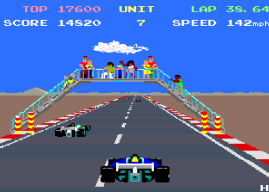
In the early days, Suzuka’s spectator facilities were
sparse.
Pole
Position 2
The first Pole
Position was a phenomenal success, and the sequel
actually did rather less well. However, it was a very
influential pioneer in a very specific field, namely the
inclusion of multiple real-life racetracks. PP1 had
dipped a toe into the water with a pretty authentic take
on the Fuji Speedway course in Japan – the first time a
real-world track had appeared in a videogame - but PP2
offered four selectable courses all based around
real-world race venues, adding recognisable versions of
Indianapolis (a simple oval), Long Beach and Suzuka.
Namco extended the
concept with their Final Lap series, which expanded the
roster with interpretations of Silverstone, Catalunya,
Spa Francorchamps and Monaco, and it’s almost as hard to
imagine an F1 game set in fictitious locations now as it
is to imagine one with only one track.
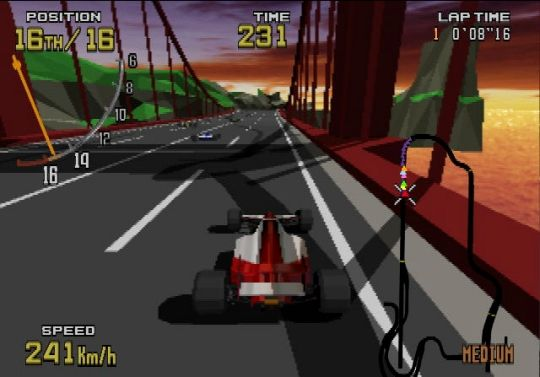
This is a shot of the rather lovely PS2 remake Virtua
Racing Flat Out, which
is well worth picking up on the excellent-value Sega
Classics Collection.
Virtua Racing
Virtua Racing is a
wonderful game, but it’s historically important for
mostly a strange and unfortunate reason. VR offered four
switchable camera positions, the best of which was the
high overhead cam which gives the driver the clearest
possible view of his racing line. But the most popular
was the first-person perspective, something which had
been rare in driving games until that point, and the
high overhead cam was immediately binned for all Sega’s
subsequent arcade racers, perhaps also because of the
extra processing demands it would make when rendering
their more complex, textured scenery.
The side-effect of
that was to destroy, almost overnight, the credibility
of the entire overhead-view racing genre - which till
then had maintained significant success with games like
Super Sprint, Hot Rod, Super Off-Road and Micro Machines
- and focus future driving-game development entirely on
the first-person view. It’s not much of a legacy for
such a great game, but history can be cruel.
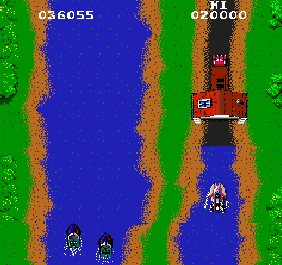
Spy Hunter: also the pioneer in the classic ‘Drive a
motorboat into the
back of a truck parked in a shed and turn it into a
sports coupe’ genre.
Spy
Hunter
Bally’s 1983 classic
Spy Hunter isn’t strictly the first racing game in which
you can directly attack your opponents with weaponry –
you could argue, for example, that Namco’s 1980 Rally-X
claims that accolade with its smoke-screens, or that
Bump’n’Jump from Data East two years later deserves it
by enabling you to actually destroy opponents. But in
the sense we understand the genre today, Spy Hunter is
the crucial first ancestor of games like Mario Kart and
Wipeout, where shooting or otherwise interfering with
your opponents is at least as important as overtaking
them. It was remade in 2001, with modest results.
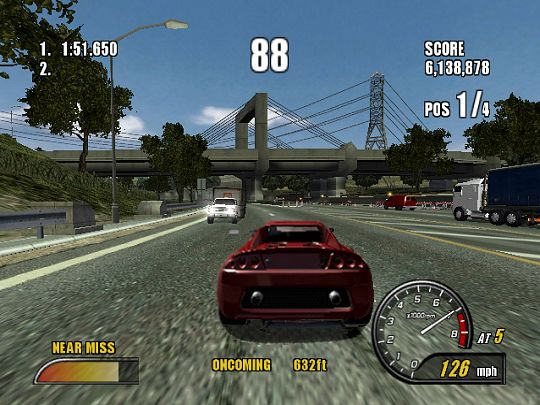
One of the best games, in any genre, of its generation.
Sadly, it was all downhill from here for Burnout.
Burnout 2
Now derived from the
1984 ram-racing template of Bump’n’Jump, The Burnout
series is an excellent example of why someone invented
the phrase “If it ain’t broke, don’t fix it”. A
franchise which started with a menacingly serious game
of almost Spartan minimalism and toughness is now little
more than a bloated, devalued insult to the intelligence
and self-respect of 11-year-olds, offering up spectacular pyrotechnics
and breathless cascades of medals and trophies to anyone
who can hold down a fire button.
But the second game in
the series is a masterpiece, combining white-knuckle
racing tension with the brilliantly cathartic interludes
of the Crash Junctions. Subsequent iterations would
screw up both elements of this simple genius horribly,
but Burnout 2 strikes a perfect balance between
challenge and reward whether you’re racing or crashing.
|
Arcade technology moved fast around this
time, and by 1980 some pretty dramatic leaps had been made, most
notably in Sega’s legendary racer Monaco GP. (Actually, at this time
the company was known as Gremlin/Sega, no relation to the UK
software house of later years. Whatever happened to Gremlin, eh?)
The first driving game to feature variable terrain, Monaco had icy
roads, rain puddles, bumpy gravel tracks, narrow bridges and
fantastic tunnel sequences where you could only see cars caught in
the narrow conical beam of your headlights, all depicted in glowing
full colour. (Monaco’s modernist graphical style still looks pretty
good today, and the game was remade for the PS2 a few years ago.)
Monaco’s unofficial sequel Turbo (1981)
saw the debut of colour 3D graphics in driving games. Innovatively
used to hide enemy cars in dips in the road, the 3D effect was
pretty solid, but it by no means sounded the death knell for 2D
racing – countless overhead-view vertically-scrolling driving games
would continue to come out for several more years, though mostly
occupying smaller, quirkier corners of the market. It was the next
3D title, however, that would properly sow the seeds of racing games
as we know them today.
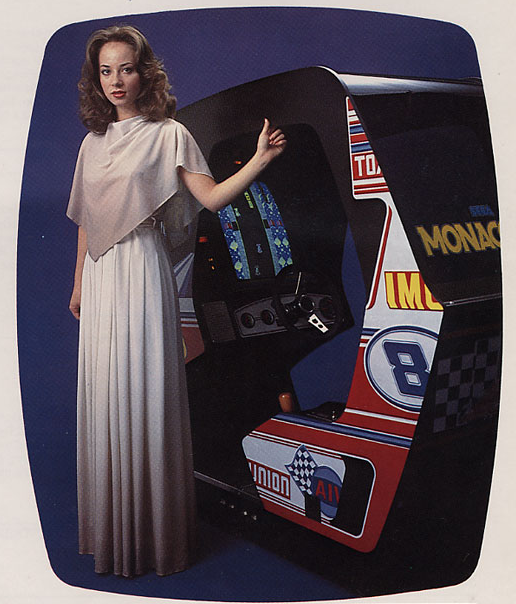 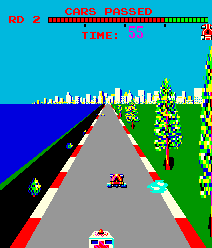
LEFT: Pit-lane groupies were much classier in 1980. RIGHT: Turbo
included the dangerous speeding ambulance as a wee tip o’the hat to
its predecessor, and also introduced classic racing-game staple, the
coastal highway.
Namco’s 1982 hit Pole Position is a
classic driving game in its own right – fast and slick with big
colourful graphics and a memorable track based on the real-life Fuji
Speedway - but it introduced a fundamental design change that made
it extra-popular with arcade owners and helped it become a
ubiquitous worldwide smash.
Pole Position was the first coin-op
racing game with a defined ending that would be reached even if you
drove flawlessly (previous games theoretically went on for ever if
you didn’t crash), putting an upper limit of about five minutes on
game time (a big draw for operators in the early 80s, when experts
had honed their skills on games like Asteroids, Pac-Man and Defender
to the point where they could play for hours and hours on a single
credit). Handling was still pretty basic – only two gears and your
car could take the tightest bends at full speed without skidding,
but Pole Position is nevertheless the grandaddy of every modern
racer, and would be the dominant influence on driving games for many
years.
The next few years were quiet in terms
of significant developments, but 1986 would turn out to be one of
the biggest watersheds in driving-game history, with banner releases
in every area of the genre, most of them coming from Sega in a
sudden determined effort to corner a market it hadn’t had
significant presence in since Turbo. For 2D fans, it knocked out a
shameless Road Fighter (see THE FORGOTTEN ONES boxout) ripoff - the
long-forgotten Space Position - and there were motocross thrills in
the shape of Enduro Racer, a distant ancestor of Sega Rally. But the
big news, of course, was Out Run. Building on the sprite-scaling
technology of the previous year’s minor motorbike hit Hang-On, Out
Run blew arcadegoers away with its beautiful graphics, varied
scenery, branching routes, evocative music and (let’s be honest
here) rather mediocre driving model.
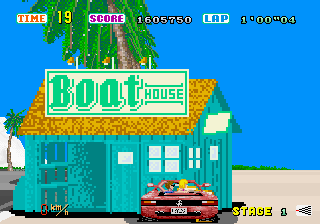
"I
told you we wouldn’t turn into a speedboat if we just drove
into this at top speed, you moron."
1986 wasn’t done yet, though, and
veteran coin-op racing specialists Atari struck back with Super
Sprint, a remaking of the very first driving game, Gran Trak 10 (see
GENESIS boxout). With stunningly crisp graphics, subtle additions to
the basic formula (shortcuts and handling-enhancing powerups bought
by picking up spanners from the track) and three steering wheels
bolted to the front for multiplayer action, it was a huge success
and a sequel, Championship Sprint (basically the same game with new
tracks) followed in arcades the same year.
Super Sprint revived the entire dormant
overhead single-screen circuit racing sub-genre, and later years
would see derivatives like Indy Heat, RC Pro-Am, Badlands (itself
the first modern-style battle-racing game) and in particular the
immortally-titled Ivan “Ironman” Stewart’s Super Off-Road generate
more big hits for Atari and others. Countless clones in arcades and
for the 8-bit home micros (including at least half-a-dozen from
Codemasters alone) also laid the groundwork for the evolution of the
genre into scrolling games like Supercars, Hot Rod and ultimately
the much-loved Micro Machines. (For an excellent modern descendant
of Super Sprint, try the wonderful download title
Pixeljunk Racers on PS3.)
|
THE FORGOTTEN
ONES
The most important driving games you’ve never heard of
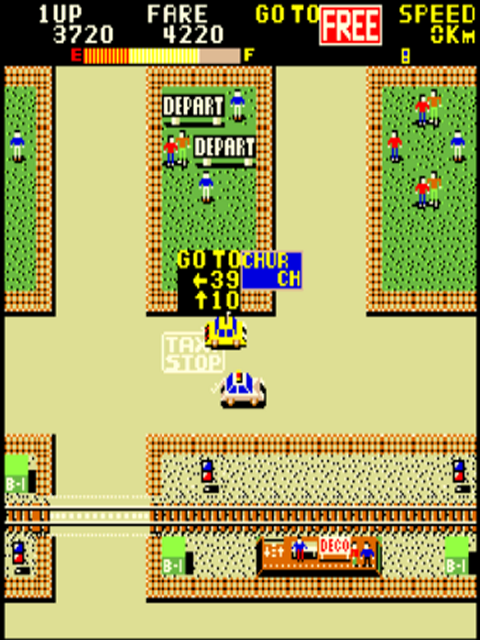
So few games nowadays ever feature the instruction ‘Go
to church’
SUBJECT: Kamikaze
Cabbie
FROM: Data East (1984)
Fully a decade and a
half before Crazy Taxi was released to massive acclaim
and success, someone had already published the game and
been roundly ignored for their trouble. Kamikaze
Cabbie’s gameplay is almost indistinguishable from its
popular descendant – the large city you can roam around
freely is there, the core “find a passenger and take him
where he wants to go” concept is the same, and it’s even
got the big arrows to tell you the way. You can get away
with bashing other vehicles around, and the fare tips
according to how fast you get him there.
It was a
massive flop, but the authors must have at least gotten
a bit of a warm glow 15 years later from the knowledge
that someone had been watching.
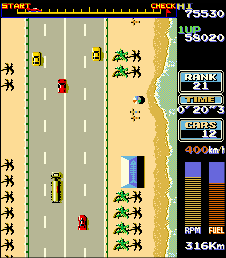
Road Fighter also inspired Out Run’s scenic themes, with
deserts
and towns to speed through as well as the classic beach
road.
SUBJECT: Road
Fighter
FROM: Konami (1984)
Alert readers of our
splendid sister title Retro Gamer will already know
about this one, but the word needs to be spread. Road
Fighter is absolutely brilliant in its own right, and
also unique as the only pure-racing coin-op ever to be
controlled with a joystick rather than a steering wheel.
More importantly in this context, though, it pioneered a
feature which it’s impossible to imagine driving games
without now, but which was a first in its day – drift
control.
Crash into another car
at high speed in Road Fighter and you don’t simply
explode (as was the fashion of the time), but bounce off
and start sliding across the road. The only way to
regain control before you plough into the walls and blow
up is to steer INTO the skid, just as you’d do in a real
car but the complete opposite of a gamer’s intuition.
It’s a small step, but it created the most fundamental gameplay mechanic of every driving game today that’s got
drifting in it, ie all of them. Ridge Racer, Daytona,
Outrun 2006, Race Driver GRID – every one of them owes a
debt to Road Fighter.
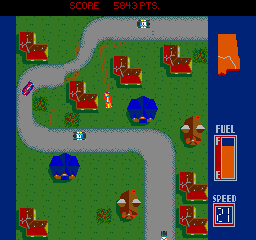
Impressively, Stocker even left tyre tracks in your wake
as you took reckless shortcuts through people’s gardens.
SUBJECT: Stocker
FROM: Sente (1984)
The most successful
racing-game franchise nowadays is the Need For Speed
series, blending fast racing thrills with a seedy crime
backstory full of stereotype “outlaw” characters with
interesting haircuts. But its roots lie in a bizarre
little arcade game born a decade earlier, which was the
first racer to concern itself with zooming across the
country outrunning the police.
Stocker (in which you
traverse several states, free to take shortcuts across
terrain and alternate routes) led directly to Test
Drive, which in turn led to Titus’ 16-bit cult classic
Crazy Cars 3 (introducing most of the character/story
elements), which is the most recognisable ancestor of
NFS.
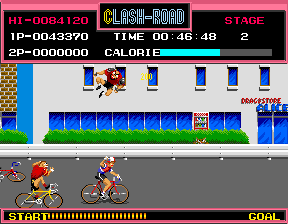
I’m
slightly more concerned that we’re all cycling to
‘Dragstore Alice’ than by the brutal road rage, frankly.
SUBJECT: Clash-Road
FROM: Woodplace Inc (1986)
Side-scrolling racing
games are a surprisingly rare beast, even in the
earliest days of gaming. There are only a tiny handful,
and almost none of them involve cars – you can have
motorbikes (Excitebike, Super Bike, Motocross Maniacs),
people (Metro Cross) or even scrawny desert birds chased
by wild dogs (Road Runner), but with the exception of
Atari’s early Drag Race game makers seem to have
something against side-viewed racing on four wheels.
Rarer still are games set on bicycles, but the
incredibly obscure Japanese outfit Woodplace not only
came up with a side-scrolling bike racer, but also
secretly invented one of the most famous series in
gaming, EA’s 1991 Road Rash.
Clash-Road (who wants to bet that EA’s game was
originally called “Road Clash”?) is a misleadingly
sedate-looking affair accompanied by a twinkly little
calliope tune, but it nonetheless bleeds violence from
every pore.
As you pedal along some lovely town and countryside
roads, you wreak carnage everywhere you go, punching out
at your opponents to knock them into roadside obstacles,
concrete barriers, holes in bridges and more. Joggers
and wildlife aren’t safe from your cycle-path psychopath
either, gaining you bonus points and energy if you mow
them down. You can be sure that the protagonist of this
game grew up to live in Liberty City.
|
1987 was mostly a year of consolidation,
with sequel releases like Super Hang-On and Turbo Outrun, along with
Namco’s spiritual successor to Pole Position, Final Lap. The most
notable release of the year was Taito’s Full Throttle, a game that’s
such a staggeringly, breathtakingly blatant ripoff of Out Run that
it’s a wonder Yu Suzuki didn’t get all his mates together, go round
to Taito and kick their heads in. However, it’s also clearly the
skeleton that would later be fleshed out into Chase HQ, so there was
a glimmer of redemption on the horizon.
The next great leap forward for the
driving game wasn’t far away, though, and in 1988 it arrived in the
shape of Hard Drivin’. One of the most genuinely groundbreaking
releases of all time, Atari came up with the first ever proper
driving simulation and also introduced the first ever true polygon
3D, amid many other innovations. Your car had four gears (for the
first time since the mid-70s), a complex functioning dashboard, a
force-feedback steering wheel and an ignition key, and you could
wander freely around the game area exploring the two different
tracks (Speed and Stunt, with its iconic loop-the-loop) to your
heart’s desire, even turning around and driving the course backwards
until your time ran out if you felt like it.
There were action replays of spectacular
crashes – another first – and the game remains practically unique
apart from its own sequel Race Drivin’. (Two more sequels were
produced but never released.) It didn’t get a halfway-decent home
conversion until its 2004 appearance on Midway Arcade Treasures 2
(Xbox, PS2, Gamecube), but finally now everyone can sample its
absolutely uncompromising brutal difficulty for themselves. After a
couple of laps of Hard Drivin’, controlling a real car is a piece of
cake.
While home formats of the time couldn’t
come anywhere close to the power required to run it, Hard Drivin’
(along with another Sega sprite-scaler, 1988’s Power Drift by Out
Run designer Yu Suzuki) did provide the raw genetic material for
Geoff Crammond’s legendary Stunt Car Racer in 1989. SCR remains one
of the most fondly-remembered titles of the 16-bit era (though it
was also ported successfully on 8-bits) and still occasionally
inspires new games like the excellent
Gripshift for the 360, PS3 and PSP. It was Crammond’s next
title, though, that three years later would go on to exert a
profound and lasting influence on the direction of the driving game
genre. That game was Formula 1 Grand Prix.
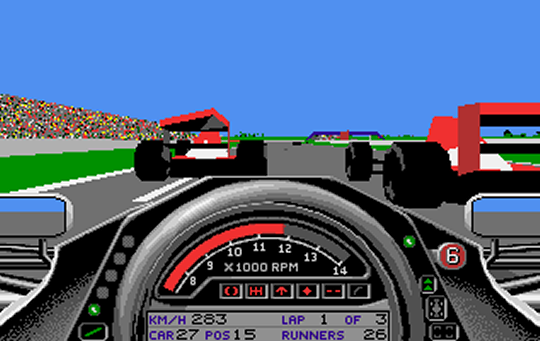
It
might not look like much nowadays, but in 1992 F1GP blew everyone’s
socks off.
Taking the simulation ball from Hard
Drivin’ and sprinting off over the horizon with it (stopping only to
pinch a few bits from Indianapolis 500, a 1989 Electronic Arts title
that was the first true simulation of a real-world race event), F1GP
was an exhaustively detailed sim, including accurately-mapped
renditions of all 16 of the F1 tracks of its day (Indy 500 had just
a single oval loop) and dozens of authentically-detailed cars.
But it was its driving model that
captivated players by the thousand – realistically complex and
demanding with endless possibilities for fiddling with the car’s
setup, the game offered you as much help with braking, accelerating
and steering as you wanted until you got used to the challenge of
controlling the car unaided, a system that’s been copied by every
“serious” driving game since. It was quite simply a masterpiece of
design and implementation, made all the more astonishing by being
essentially the work of a single person. Every F1 game of the last
17 years is basically just this with better graphics.
1992 also saw the release of another
driving game every bit as influential as F1GP (and even more
successful), but which couldn’t have been any more dissimilar to it.
Super Mario Kart came out of nowhere, a seemingly-throwaway spinoff
release which appeared fully-formed with barely a note of fanfare
but went on to become one of Nintendo’s most valuable bloodlines.
Knocked together so quickly it doesn’t
even have a proper single-player mode (solo racers still have to
drive around in a split-screen letterbox, with half the display
wasted on a near-useless map), SMK was nevertheless a runaway hit,
helped by not only being able to race a friend on the normal
grand-prix tracks but also in a brilliant balloon-popping deathmatch
game that’s never been bettered by any of the many sequels. (Other
titles in the series have notably better single-player courses and
play mechanics - particularly Mario Kart 64 – and have permitted the
participation of many more players, but none have ever approached or
even simply replicated the genius of SMK’s deathmatch game.)
|
THE ICONIC
CHARACTER
Reiko Nagase (Ridge Racer Type 4)

Racing games are one
of the few remaining genres where (with the exception of
the Need For Speed series and a handful of others) the
player predominantly plays as themselves, rather than as
a predefined character in a story. As a result,
characters are rather thin on the ground – if anything,
the cars are the stars. But nobody wants to read 600
words about the Nissan Skyline (nobody who doesn’t
urgently need drowning in a bucket, anyway), so instead
we’ll seize on the chance to get a bit of eye candy in.

Ironically, of all the
Ridge Racer games, Type 4 is the only one that IS
burdened with something approaching an ingame plot, but
it’s got nothing to do with “Reiko Nagase”, a made-up
lady whose only job is to add a bit of class and glamour
to the intro. She pulls it off memorably in one of the
very few videogame opening scenes worth watching, 100
seconds of sheer soft-focus genius which deftly and
wordlessly encapsulates the entire ethos behind Ridge
Racer.
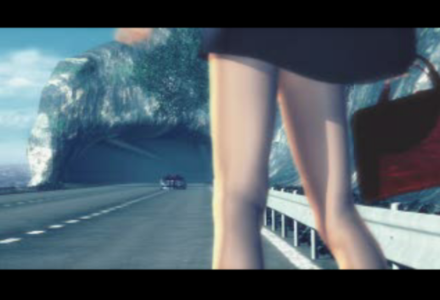
Indeed, so perfect is
RRT4’s atmosphere-defining introduction that when
imaginary Reiko was dumped in favour of the
equally-unreal “Ai Fukami” for Ridge V (Reiko actually
first appeared in Rage Racer, but without any kind of
story), fans made such a fuss that she was brought back
for 6 and 7.
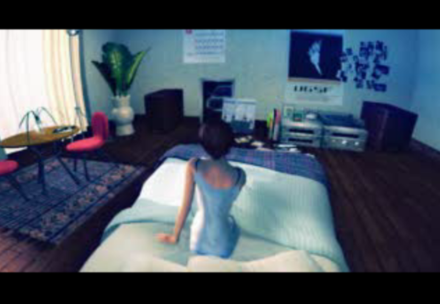
We first meet Reiko
sitting up in bed in her immaculate,
tastefully-minimalist apartment. She appears to be a
young secretary (according to Namco’s subsequent
“biography” she was 23), and we next see her apparently
heading off to work through a rundown-looking industrial
dockland area.
All this is designed
to make Reiko look tiny and delicate and serene, and
accordingly is shot with very static cameras, but is
spliced with furious, fast-cutting action-movie images
of high-octane racing, with huge metal cars thundering
down the track, smashing into each other and the
roadside barriers and flying off the tarmac into the
air.
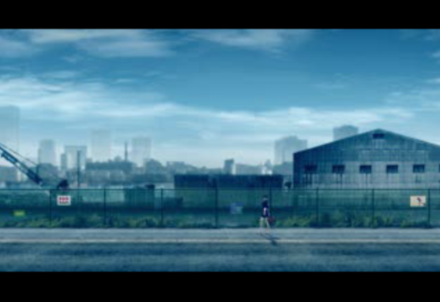

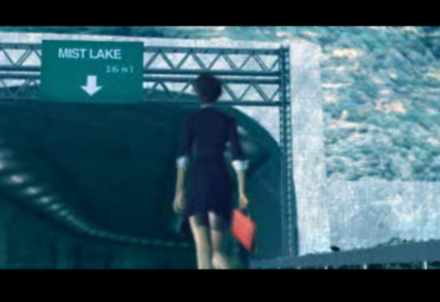
The deliberate
contrast between the fragility of little human Reiko and
the brutal machinery of the racing cars is further
emphasised when, as she passes some towering skyscrapers
and walks on through one of the trademark Ridge tunnels,
the heel snaps off one of her shoes. (It’s such a nice
day that she seems to have spontaneously decided to
eschew the daily grind of work and head off towards the
coast, which in Ridge Racer games is always conveniently
close to the city.)
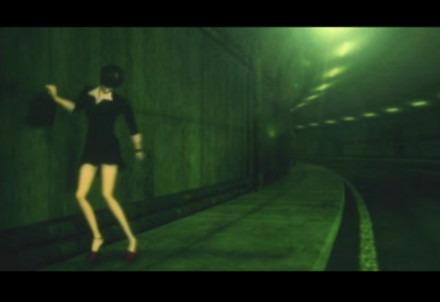

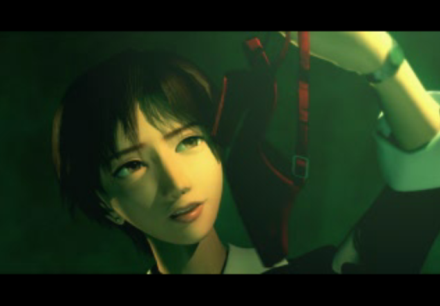
She rolls her eyes and
continues walking, now on the road itself, as the
coastal highway has no pavements. Hobbling along with
one shoe in her hand, she cuts an even more vulnerable
figure than before, and suddenly we switch back to the
race and realise, in some alarm, that the cars are
hurtling down the very same road Reiko is walking along.
But our brave heroine,
hearing the roar of approaching engines, doesn’t fret.
Instead, she turns and calmly sticks out a thumb to
hitch a lift.
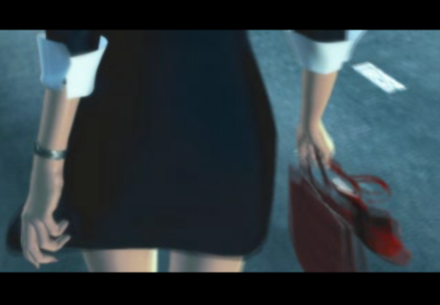
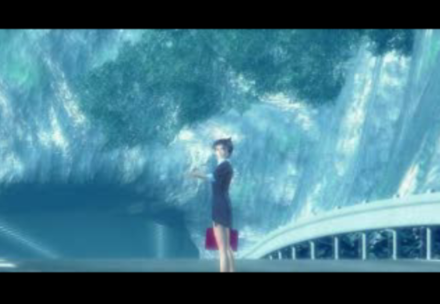
By now, an especially daring and reckless overtaking
manoeuvre has seen the silver-grey Solvalu 02 barge its
way to the front of the pack and establish a lead. As it
speeds out of the tunnel into the dazzling sunlight, the
driver spots Reiko and slams on the anchors. What’s the
point in winning the race, after all, if you can’t stop
to help out a pretty girl in a short skirt along the
way?
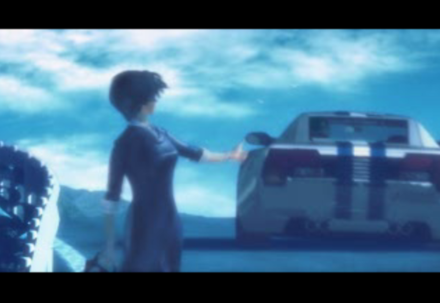
We get a view from the driver’s seat, catching a glimpse
of his reflection in the passenger window. The driver,
too, is a faceless machine-like being hidden behind a
helmet and driving suit, but the reflection disappears
as the electric window winds down, first revealing the
sparkling ocean, then Reiko as she approaches in the
wing mirror, and finally her face as she leans in
hopefully.
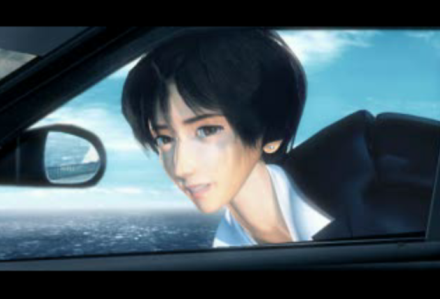
She flashes a sweet,
heart-melting smile and then we see her feet – one
shoeless, slight and exposed between the hard steel of
the car and the hot, unforgiving tarmac – as she climbs
elegantly in. There’s still no sign of the other racers
as the Solvalu gets back under way, cresting a hill with
just the ocean and the horizon in sight.
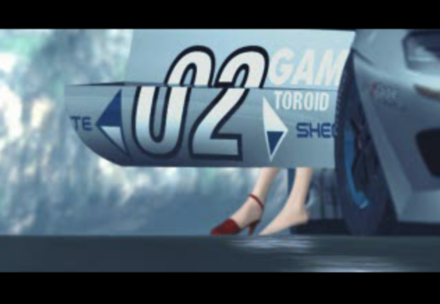
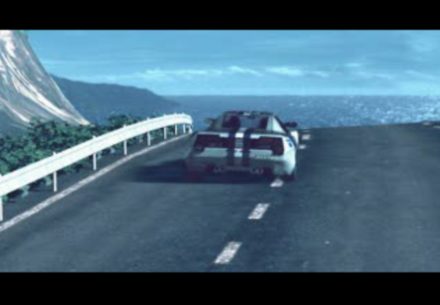
Shortly afterwards, we
see it rocketing over the familiar finish line - raw
power and unspoiled beauty fused together in the spirit
of optimistic, soulful humanity that sets the RR series
apart from its ugly, macho and joyless competitors - as
the screen fades to black and the opening greeting
flickers into life.
“Welcome to the world of Ridge
Racer.”
|
With occasional exceptions like Mario
Kart and successful series like the Lotus Challenge games on the
Amiga and Atari ST, driving games on home formats were still fairly
rare in 1992, as even pseudo-3D racing stretched the hardware of the
era to its limits. The arcades, though, posted notice of what was to
come with the release of Virtua Racing, Sega’s magnificent and
groundbreaking true-3D classic that took Hard Drivin’s fully-built
and freely-navigable worlds and finally gave them racing speed. It
was the following year, however, that would be the biggest watershed
in the history of the genre. 1993 saw the debuts of Ridge Racer and
Daytona, two coin-op hits which would turn out to be the flagships
of the next generation of home console wars.
The two games have much in common, not
least the exaggerated drift-based handling style that’s almost
ubiquitous now but was still in its infancy at the time. Ridge,
though, narrowly made it to market first, and a frankly incredible
Playstation conversion - put together by a tiny handful of people in
just six months for the machine’s launch - all but strangled the
Saturn at birth. While it actually did very well as a translation of
the coin-op’s gameplay, Daytona Saturn’s atrocious pop-up, crude
textures and iffy framerate were an embarrassment next to the crisp,
near-arcade-perfect PS rendition of Ridge Racer, creating a
perception of technical inferiority that was only partially true but
would hamper the Saturn all its life.
The game, too, has been generally held
by history to be slightly inferior to its Namco rival, as evidenced
by the numerous sequels to Ridge, while Daytona only managed one
(unsuccessful) arcade follow-up and none on home formats. (That's
unless you count the four semi-sequel reworkings of the original
game which appeared on various formats and in various territories:
Championship Circuit Edition, Deluxe, Circuit Edition and 2001,
which between them contributed six new tracks and several other new
features, arguably making them equally valid as sequels as
standalone titles like Ridge Racer Revolution.)
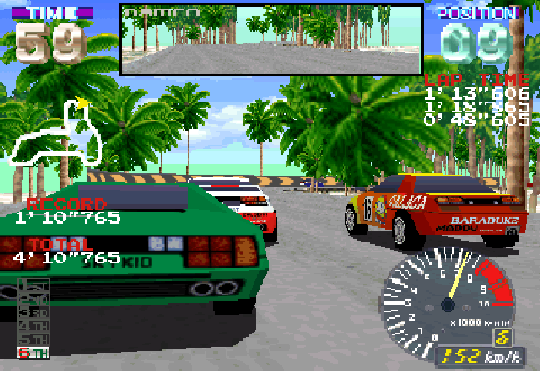
Blue, blue skies in Ridge Racer Revolution, the first of many
sequels to Namco’s all-time classic.
Historians differ on the reasons for
Ridge Racer’s ultimate victory - and indeed in arcades you’re
still more likely to encounter Daytona cabinets, because Sega
far-sightedly concentrated more on installing up to eight linked-up
multiple machines whereas Namco’s flagship was the stunning
single-player-focused “Full Scale” edition of Ridge, featuring an
entire real Mazda MX-5 car for the driver to sit in, which took up
as much space as four Daytonas but only brought in one credit's
worth of money at a time.
Some point to Ridge's much friendlier
drifting model, but the most convincing argument centres around
character. While Daytona has very distinctive, memorable courses,
they’re oddly sterile and soulless, something which can be
attributed to the bizarre near-total lack of buildings in them -
apart from two tiny stretches of Seaside Street Galaxy, there’s
nowhere in Daytona that anyone might live, which is odd for a game
carrying the name of a real-life place.
While RR appears to take place in a real
city packed with skyscrapers, hotels, billboards and petrol
stations, instantly engaging the player in a captivating and
believable environment reinforced by an excitable commentator,
Daytona is set in a ghost world, with bridges and tunnels leading
from nowhere to nowhere and no sign of human habitation except the
disembodied voices singing the famous backing songs, and the game
simply doesn’t create the same emotional bond with the player that’s
sustained the RR franchise for 15 years.)
|
DEFINING MOMENTS
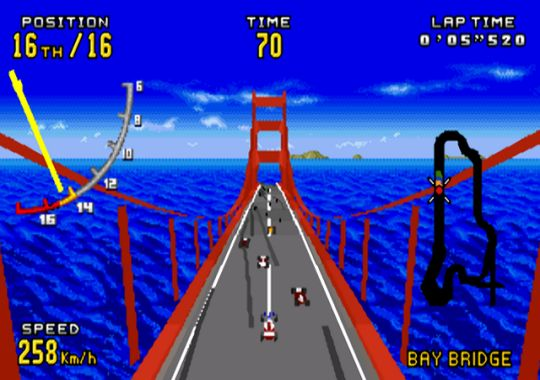
Now this is a terrible maritime disaster waiting to
happen.
A View To A Kill
Game: Virtua Racing
We’ve already
mentioned the unfortunate unintended consequences of
Virtua Racing’s biggest innovation, but it’s hard to
overstate just how thrilling it was in 1992 to be able
to swoop up and down like Superman over the three iconic
VR racetracks. The camera’s lightning-quick,
ultra-smooth zoom-in from the Scalextric-esque
helicopter view to the inside of the driver’s helmet
(quiet at the back, there) and out again was an
intoxicating demonstration of the power and potential of
the coming hardware generation, and nothing can ever
quite match that first high of new experience.
So much so, in fact,
that certain people we know, who shall remain nameless,
spent their whole first credit just marvelling in the
pit lane and completely forgot to actually start the
race before their time ran out.
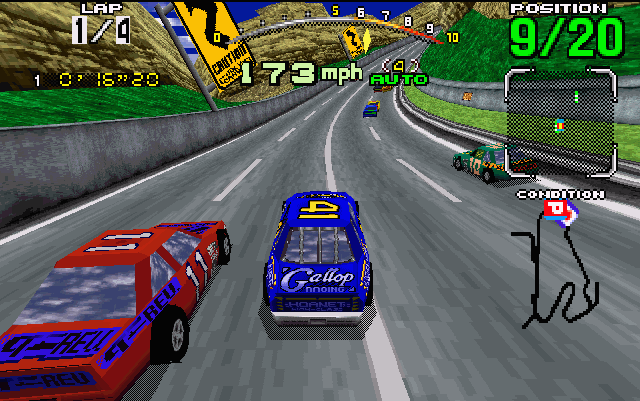
Excitingly, the Model 2 Emulator is on the brink of
making 8-player online
Daytona a reality, but it’ll never eclipse the sheer joy
of doing it in real life.
Keep Your Enemies
Closer
Game: Daytona USA
No arcade game has
ever generated more multi-player income than Daytona
USA, and that’s because if you can get seven mates all
in the arcade at once, nothing in videogaming comes
close to an eight-player Daytona race. (Which is why you
can still find the huge, space-swallowing eight-cab
setups in big arcades 15 years later – graphics be
damned, people will always pay money for an experience
this good no matter how rough it looks.)
All sitting in
your own majestic cockpit cabinets, the screen shows you
exactly who you’re racing against and exactly who just
sneakily shunted you into the vast, cripplingly slow
grass verge on the huge bank turn of Dinosaur Canyon. If
they’re in the “car” next to yours , the temptation to
just lean out of the cabinet and smack them one in the
face can be almost overpowering.
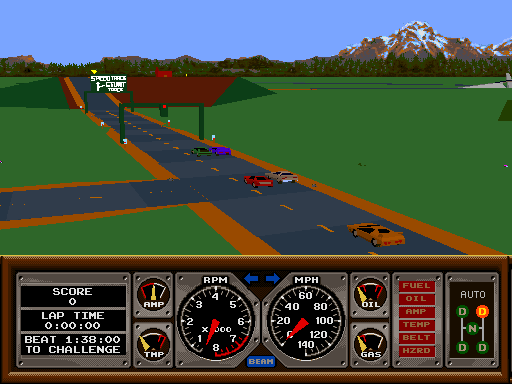
It’s a shame nobody’s built a real-world version of the
Hard Drivin’ race park you could take your own car
round. The hundreds of deaths annually would be a small
price to pay.
Head Over Heels
Game: Hard Drivin’
If the car in Hard Drivin’ were a real one, the
manufacturers would have been sued into bankruptcy over
its lethally skiddy handling and sloth-like
responsiveness. It would have been dangerous enough to
take it down to the shops to buy some milk, but to try
to get it all the way round a giant concrete
loop-the-loop was positively suicidal.
As the angular polygons struggled to keep up with
spinning the entire horizon around AND convey the
lateral movement of the road round the loop, the first
time you ever successfully came out the other side in
one piece felt like it must have been for Neil Armstrong
when he walked on the moon. The sense of achievement,
coupled with the opening up of a whole new sandbox world
of possibilities, was even more dizzying than the loop
itself.
|
In truth, 1993 marked the end of major
innovation in the driving genre, and everything that’s happened
since has been basically a logical evolution of the gaming DNA that
was already in place by that time. Wipeout on the Playstation, for
example, represented a cultural and economic phenomenon, but in
gaming terms it’s just Super Mario Kart with futuristic graphics.
1995’s Sega Rally created a sub-genre of rallying titles, but the
meaningful differences between it and road-racers like Ridge and
Daytona were largely superficial (and invented by Monaco GP anyway),
although it would eventually develop into the likes of Motorstorm,
where the effect of different terrain becomes so significant as to
genuinely alter the core gameplay mechanic.
(Motorstorm’s other
parent, incidentally, is the 1996 Konami find-your-own-route coin-op
GTI Club, whose lack of a home port was one of the great tragedies
of driving game history until it appeared as a PS3 download game in
2008.)
That leaves us with only two significant
strands of driving-game bloodline left to chart, a pair of close
relations which comprise the two most prominent brands in the modern
genre. The 1997 release on the Playstation of Gran Turismo was half
of a cultural double-whammy that ended the brief Wipeout-inspired
era of console games being seen as hip and cutting-edge in the wider
world of fashion. While lifestyle magazines like The Face had for a
while been dazzled by the Designers Republic stylings and big-beat
soundtracks of the futurist hover-racer, and also by the iconic “girl-power”
figure of Lara Croft, Gran Turismo (along with its spiritual sibling
Final Fantasy VII) swiftly reasserted the jealously-guarded reign of
the traditional obsessive, conservative and socially-dysfunctional
nerd over the world of videogaming.
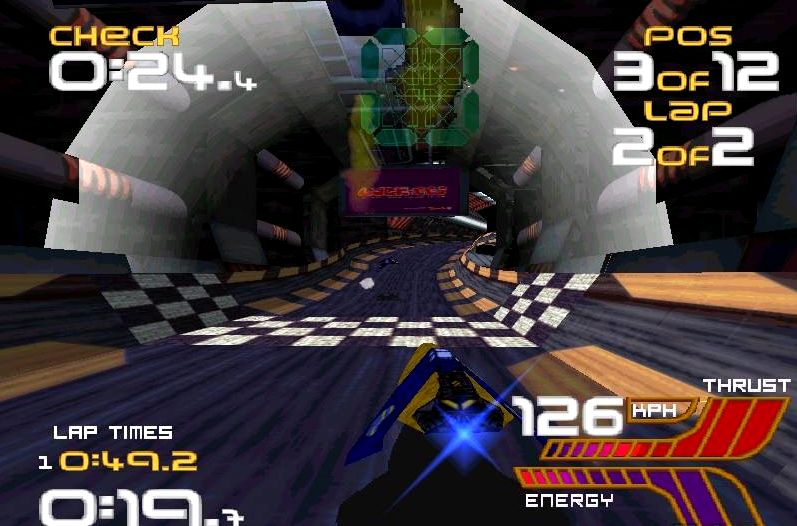
WipEout – very, very briefly making games cool.
Not so much a driving game as a
simulation of being a pit mechanic and a used-car dealer rolled into
one, GT picked up an oily baton from Geoff Crammond’s F1GP and
distilled it even further, fixating on a strange and
highly-selective definition of “realism” aimed at science geeks with
Obsessive-Compulsive Disorder.
(As opposed, that is, to the
replication-by-exaggeration of the adrenaline rush of high-speed
driving that had been the goal of Ridge Racer designer Fumihiro
Tanaka. One of the developers of the PS version recently explained
the concept to our splendid sister magazine Retro Gamer: “Ridge Racer is
different from other companies’ racing games - even for people who
can’t drive in real life, if they play Ridge Racer they get a sense
of how good it must feel to drive fast.” This ethos has most
recently been seen in Sega’s fantastic modern updatings of Out Run.)
In GT, reckless thrillseekers are
immediately discouraged by interminable technical “licence tests”,
bearing no relation to the skills required in actual races, before
they’re allowed to enter one at all. Yet conversely, the game inflicts only the
smallest of penalties for smashing into opponents at 220mph. Go
figure. Tracks,
too, are largely identikit grey professional circuits, with a few
more-exciting street courses grudgingly thrown in for a bit of
variety.
|
GENESIS
Gran
Trak 10
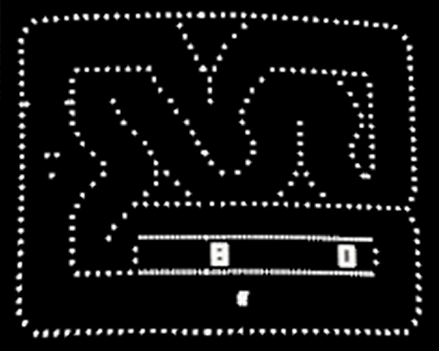
Later reworkings of the Gran Trak design, like the
Sprint games,
featured much wider roads and less punishing track
design.
Alert
viewers will of course know that the start of this
article is a great big fat heap of lies designed to
catch out trainspotters who only read the first
paragraph then send in angry letters of complaint.
The REAL first videogame driving experience ever actually happened in
1974, when Atari released a game called Gran Trak 10.
One of the first wave of arcade games, which actually
operated via dedicated solid-state electronic circuitry
rather than on ROM chips, it’s long since been forgotten
by gaming history.
It
looked a lot like Sprint, but with a single more complex
track, and there were no CPU opponents – you simply
raced against the clock until time ran out, with only
oil slicks and the track walls as danger.
The company released
several other pre-Night Driver driving games on the same
sort of technology, including the scrolling Hi-Way, Indy
800 (an eight-player game similar to the later Sprint 8)
and the peculiar demolition derby Crash’n’Score, as well
as a two-player version of GT10 called Gran Trak 20,
which have all suffered the same fate – there are few if
any surviving examples of the original machines, and the
solid-state design means that none of the games are ever
likely to be emulated.
To all intents and purposes, then, none of them can be
meaningfully said to exist, and history starts with
Night Driver.
|
But the world comprises more dullards
than superstars, and accordingly the GT series has shifted close to
50 million copies across the globe so far, not counting the
suffocating hordes of less-accomplished clones it also inspired
(even getting one into arcades, in the shape of Sega’s 1999 uber-sim
Ferrari F355 Challenge). But one game which attempted to merge GT’s
nerd appeal with the character and exhilaration of Ridge has been
almost as successful, at least in terms of reaching its potential
audience.
Metropolis Street Racing arrived on the
Dreamcast in 2000, and applied realistic driving physics and
real-life cars to a game not only set in glamorous and
accurately-mapped real-world city streets, but which also rewarded
the player for irresponsible show-off stunt driving. (Another
example, incidentally, of the influence of GTI Club.) Escaping the
bonds of Sega’s doomed console for the Xbox and undergoing a name
change to Project Gotham Racing, the series went from strength to
strength, and offers car geeks a slightly more exotic and expressive
way to indulge a borderline-autistic collecting mania. (Whoever said
that GT and PGR were basically Pokemon for slightly older gamers was
a wise sage indeed.)
And that’s pretty much it for now. Every
driving game of the last decade or more has been derived - with
varying degrees and elements of crossover – from half a dozen basic
part sets, namely Ridge Racer, Out Run, Wipeout, Crazy Cars 3, GTI
Club and F1GP, and there’s little sign of that changing in the
forseeable future, despite about one game in every three released
for the major consoles being a driving title of some sort or
another. Perhaps only an unlikely flop for the (sort of) imminent
(ish) GT5 could cause a real shake-up in the status quo, and it’d
take a brave man indeed to predict that.
|

